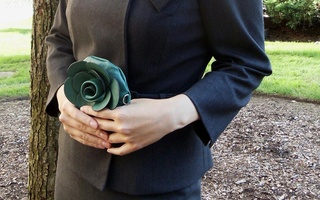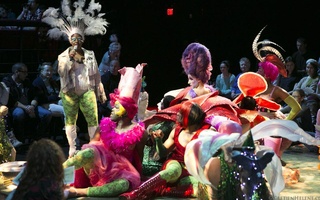On Halloween, if you donned a headdress and dubbed yourself Squanto, you may have committed racism.
I would give you the benefit of the doubt, but Native Americans at Harvard College might be less indulgent. Last Friday, the club sent students an e-mail entitled, “We Are Not a Costume.” The message urged readers to avoid “culturally insensitive costumes” like “the quintessential Pocahontas or Indian Squaw or the hypersexualized Geisha.” Such outfits, the group warned, “reinforce centuries of cultural stereotypes and racism.”
But costumes by definition are exaggerations, and this accusation of racism is overblown.
Not everything in the e-mail was objectionable. November is Native American Heritage Month, and the group wanted to spread awareness of this fact. The message highlighted Native Americans’ contributions to our culture, of which some people may be unaware. For instance, a Nipmuc printed the first Bible in North America. And the Founders studied the Iroquois Confederacy when designing our government. Part of the club’s mission is to “to educate the Harvard campus about Native issues and address popular misconceptions of Natives.” In this pursuit, the group has a worthy goal.
Unfortunately, the charges of racism overshadowed this effort. Even worse, the blunt e-mail wrote its own parody. When reacting to the message, some students mimicked its harsh tone. On the Voice’s blog, Noice, a writer satirized the e-mail in a post, “Hey You! Yeah, You. Your Costume is Straight Up Racist.” She summarized the group’s comparison of these costumes to African American stereotypes: “It’s like wearing black face, you ass.” Meanwhile, a student on Pfopen, Pforzheimer House’s e-mail list, sarcastically responded: “…all costumes are not stereotypes. All nurses are slutty looking and all teachers wear short skirts.”
On the other hand, Thomas S. Miller ’11, the club’s president, told me that the feedback he received was “almost entirely positive.” “I’ve gotten a ton of e-mails from students who want to learn more about Native culture,” he said. In this sense, the message was successful. “If it had not been controversial, it wouldn’t have gotten all this attention,” Miller observed. But this e-mail is only the group’s second so far this year. Maybe those students just didn’t know the club existed.
Still, the group finds these costumes disrespectful. They are, after all, exaggerations of Native Americans’ attire. “It’s kind of a stepping stone,” Miller argued. “It leads to thinking about people in a certain way.” This argument is plausible but not airtight. Puritan costumes are exaggerations—few Pilgrims wore belt buckles on their hats—yet we don’t consider them invidious. Besides, Halloween is frivolous, and most people understand it that way. They may dress like gangsters, but they know that most Italians are law-abiding. They may wield sewer caps, but they know that most Ninja Turtles are well groomed.
Then again, these costumes mock Native Americans’ traditional garb. “People don’t recognize what they’re wearing is sacred; we’re trying to raise awareness,” Miller said. But even if people recognize what they are wearing, does their awareness make a difference? Catholic priests and nuns are popular costumes, yet the beadles at St. Paul’s Church do not demand apologies. These costumes are poking fun at religious vestments, but in a good-humored way. To live in a diverse society, groups have to take harmless spoofs of their culture in stride.
More importantly, if people too often accuse others of racism, the charge will lose its currency. NAHC is right to oppose stereotypes of Native Americans, but these costumes are not the best targets. If students remember them as the club that cried “racist” over costumes, they may be less inclined to listen when the group identifies truly virulent racism in our midst.
Outrage over stereotypes needs the proper outlet. Racism is a damaging force, both blatantly and subtly, but sometimes it isn’t subtle—it’s non-existent. The NAHC should continue to spotlight misconceptions about its culture and educate people about its heritage. But it should leave the would-be Pocahontas alone. She’s not racist; she’s just unoriginal.
That said, Native Americans will not have to worry about me for future Halloweens. I won’t be sporting moccasins or carrying tomahawks. They’re not my style. For me, the “tortured writer” look comes much more easily.
Brian J. Bolduc ’10, a Crimson editorial writer, is a economics concentrator in Winthrop House. His column appears on alternate Tuesdays.
Read more in Opinion
Something MoreRecommended Articles
-
 Professor Fashion: Professor Tomoko L. Kitagawa
Professor Fashion: Professor Tomoko L. Kitagawa -
A Night To Be FreeIt is our continual urge to moralize on the subject of sexualized costumes that should give us pause, rather than the costumes themselves.
-
The Utility of Race JokesWe need a practical solution to racism, and race-based humor and embracing stereotypes is a great way to conquer racism.
-
 How to Make the Man
How to Make the Man -
This Halloween, Choose RespectWhen you dress in blackface or a Native American headdress for Halloween, you’re placing yourself in association with a history of Western imperialism, slavery, and violence against minority groups.
-
 Coordinates: The Garment District
Coordinates: The Garment District













